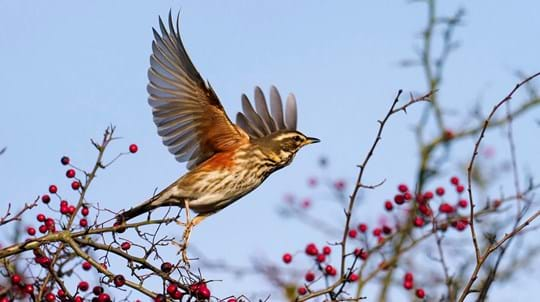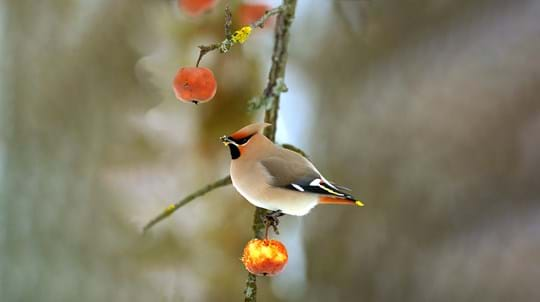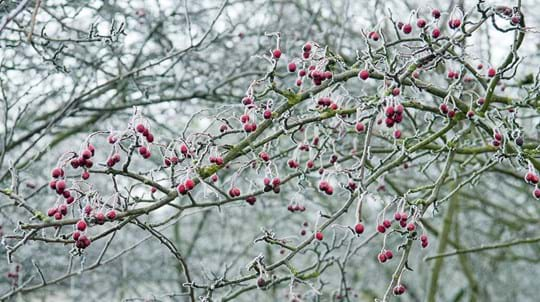Who's been there?
Learn how to track elusive woodland animals with our poos and clues swatch book
Buy it now
Content manager
A woodland coated in snow is one of winter’s most magical images. Take a closer look and you might be able to glimpse into the secretive lives of some of the animals that live there.
As they move across the snow-covered ground, animals leave footprints, known as tracks. These tracks can tell us what creatures are living in the wood and give us insight into what they have been up to. Venture into your nearest woods and see what you can learn about the animal inhabitants - snow is great for revealing their movements but you can find tracks in sand and wet mud too. Here's how to identify some of the tracks you might encounter.
Foxes and many cats leave a straight line of pawprints. This is because each back foot tends to overlap with where the front foot was on the previous step.
Snowfall reveals the movements of this wily hunter, which roams the woods in search of its next meal.
Appearance: four toes - two at the front and one at each side – and a roughly oval-shaped pad at the rear. Claw marks may be visible at the end of each toe.
Size: around 5cm long, 4cm wide.
Could be confused with: dog tracks, but they can be told apart:
Learn how to track elusive woodland animals with our poos and clues swatch book
Buy it nowTheir nocturnal habits make badgers hard to see, but tracks in the snow can show us where these beautiful animals have been on their nightly wanderings.
Appearance: five toes above a broad rear pad. Claw marks may also be visible.
Size: 5cm long, up to 6.5cm wide.
Could be confused with: cat tracks, but there are differences. Cat tracks only show four toes and no claw marks, as they retract their claws when walking. Cat pawprints are smaller too at around 3.5cm long and 4cm wide.
At a glance, wildcats look very much like our domestic cats though are generally larger. Prints will be similar, so look out for other signs to confirm which animal you’ve spotted.
Visit a snowy woodland and there’s a good chance you’ll see some rabbit tracks. Rabbits are social creatures so you may see lots of their tracks crossing each other in the snow.
Appearance: a pair of long, thin prints and a pair of shorter prints, as rabbits’ hind feet are much larger than their fore feet. They have four pads on both fore and hind feet.
Size: front feet are around 3.5cm long, 2.5cm wide. Hind feet are more than twice as long, although rabbits don't place the whole of the back feet on the ground when they run.
Could be confused with: hares have similar prints but are much larger than rabbits, so stride length may be longer. Hares tend to live alone on open land, so if you're in woodland with multiple tracks, it's most likely the tracks belong to rabbits.
Each of the UK’s deer species has similar tracks. It can be hard to tell different species apart, although size can be a clue.
Appearance: hooves leave two long imprints with a gap in between.
Approximate size:
Could be confused with: sheep tracks, although those of sheep tend to have more rounded ends, while the front of deer tracks typically come to a point.
Tracks of red squirrels and grey squirrels look the same but your location will be a clue to which species you have found.
Appearance: footprints show several pads surrounded by all five toes and usually claw marks too. Tracks may look like a group of tiny spots or even small handprints.
Size: front feet are 3.5cm long and 2.5cm wide. Hind feet are 4.5cm long and 3.5cm wide.
Could be confused with: rabbit tracks. Both squirrels and rabbits have small front paws and longer back paws, but due to their furry feet, rabbit tracks are generally less defined than squirrels'.
These four members of the mustelid family leave similar tracks that vary in size.
Appearance: five toes in a star shape, though often only four show. Claw marks may be visible.
Approximate sizes:
Could be confused with: each other! The tracks vary in size but there’s considerable overlap between them, so keep your eyes peeled for other evidence to confirm what you’ve found.
Look for otter tracks along the waterside.
Appearance: Asymmetric footprints might show only four of their five toes. You may be able to see the webbing, but usually no claw marks.
Size: 6-9cm long, 5-7cm wide.
Could be confused with: mink prints are similar but much smaller, while dog and badger prints include claws.
Hedgehogs hibernate in winter so it's unlikely you'll spot their tracks in snow, but you may see them in mud or sand at other times. Identifying hedgehog prints can be tricky as many animals leave similar-sized tracks.
Appearance: prints often show four toes although hedgehogs have five. Claw marks don’t usually appear. Front feet are wide and leave tiny handprint-like tracks, while the back feet are slightly longer and narrower.
Size: around 2.5cm long, 3cm wide.
Could be confused with: stoat tracks are a similar size and shape, so look for other evidence to confirm which you've likely spotted.
Bird tracks are easily distinguished from those of mammals, often looking like arrowheads. Those you are most likely to encounter in woodland are birds that spend much of their time on the ground, like pheasants and blackbirds.
Appearance: long and thin, bird tracks often look a little like arrowheads. It can be difficult to identify species from a track alone.
Size: various.

Primordial landscapes, tangled branches, breathtaking wildlife and miles of woodland trails. From the countryside to cities, we care for thousands of woods throughout the UK, all free to visit.
Find a wood near you
Blog
Charlie Mellor • 20 Nov 2023

Blog
Rory Morrow • 13 Jan 2025

Blog
Charlotte Varela • 21 Jan 2025

Blog
Charlie Mellor • 26 Nov 2021

Blog
Charlie Mellor • 29 Nov 2018